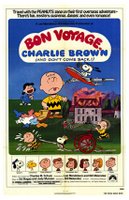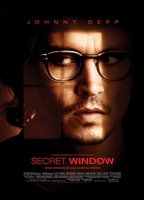
Charlie Brown is your typical everyday kid. He has trouble with the girls, his baseball team has a very consistent loosing streak, he cowers in fear of a kite-eating-tree, and his dog has a strange obsession of flying his red 'Sopwith Camel' dog house. Well, maybe he isn't your average kid, but the blockhead and his friends have been entertaining children and adults alike since 1950. Needless to say, the comic series has spawned much commercial interest, including four feature length films.
The last of the four films, Bon Voyage, Charlie Brown (and Don't Come Back!) (1980), throws good ol' Chuck into yet another sticky situation that will require his intelligence, wit, and friends to get out of (we're doomed). This time, Charlie Brown (Arrin Skelley) and his classmates Linus van Pelt (Daniel Anderson), Peppermint Patty (Laura Planting), and Marcie (Casey Carlson) manage to become foreign exchange students to the town of Le Heron in France. Another surprise awaits Chuck at home: his very first letter. Except it's in French. Know-it-all Marcie translates the letter for Chuck, revealing that he has been invited to the Château Mal Voisin, or the Château of the Bad Neighbor [dramatic cord].
After a round of tennis at Wimbledon, the gang leaves England and arrives at France. Peppermint Patty and Marcie are dropped off (they're staying with a different host, because they go to a different school), and Chuck, Linus, Snoopy and Woodstock arrive at the Château of the Bad Neighbor [dramatic cord]. With no one to great them but locked doors, bad weather, and rumors of the ill tempered Baron (not to be confused with Snoopy's archenemy, the Bloody Red Baron), the gang is forced to camp outside. Mystery continues though, and it seems as if no one is safe. Who sent the letter, and why are they locked out of the Château? Who mysteriously gives them food and blankets under the cover of night? Why does the Baron hate foreigners? How come Charlie Brown is such a blockhead? Most importantly, why can't I have a normal dog like everybody else? Although the film was created to teach young children about countries overseas, Bon Voyage manages to brilliantly combine the educational lesson with the original story, resulting in a simple, yet great, family film.
The majority of the film, although a family film, is symbolic. For example, the town name Le Heron is the most obvious case, representing a heron (and as Marcie says, "That's a bird, a big bird Chuck"). However, as stated earlier, the film is intended to teach children about England and France, so all town names (including Le Heron) are real places. The heron usually is an omen for good luck and prosperity, something that the town could definitely use, but can also be warning of fire. Indeed, this foreboding does come true at the end of the film, and Charlie Brown must use his instincts to save Linus and the resident of the Château. Another aspect of the symbolism revolves around the Baron. The Baron has a very negative inclination towards everyone, especially foreigners. As this is a mystery, the dark atmosphere is kept up with the almost constant rain that pours over the Château. The Baron's negative feeling towards everyone seems to have materialized in the form of the bad weather, as proven towards the end of the film, with the elimination of the bad feeling and weather. Unfortunately, the heron's warning of fire is ignored, and the Château is tragically set on fire. Fire is symbolic of a cleansing, such as the mental cleansing of the Baron's attitude. Once the fire is over, the Baron apologizes for his behavior as a bad neighbor, and decides to turn over a new leaf.
Although the Baron is never really shown, along with most adults, the Peanut tradition is broken for the first time, and possibly only time, as an English speaking (and French speaking) adult is shown speaking. When Charles Schulz created Peanuts, he wanted to show it through the world of a child. Therefore, adults are never shown, and when speaking say the trademark "Wah wah wah". The new introduction of adults into the world of Peanuts could be a cultural view of adults across the sea. Adults here could be viewed as uncaring in their children's lives, while the 'foreign' counterparts are shown because they care. The Baron, someone who obviously doesn't take an active role in his daughter's life, is never shown. However, the caring grandparents who always allow a second cookie are shown in memories, such as photographs. (Charlie Brown's grandfather is shown, and we finally learn that his baldness is genetic)
When the inevitable fire occurs, both Charlie Brown and the Baron have similar reactions. They (quite literally) run around in circles, screaming for help. Charlie Brown, however, shows initiative and runs around in circles looking for help. In fact, all of the children show initiative, and the only reason the Château survives is because of the children. If it wasn't because of Charlie Brown's quick thinking (and running), the Château, and Linus would be forever gone.
The climax of the film, the Château ablaze, is one of the most beautifully put together scenes I have ever seen. The artwork, music, and lines are all magnificent and haunting, simple yet complex, and create an awe inspiring feeling to anyone who views it. This is very appropriate, for fire should create the same feeling, especially when the fire threatens someone's life. The most poignant part is when the Château is viewed from the house of Peppermint Patty and Marcie. Although seen from a distance, the flames are easily visible, and the thought of someone encased in that torturous situation is as intense as the heat.
The symbolism continues even as the film ends, while the credits role. The three countries featured in the film, America, England, and France, coincidentally share the same colors on the flag (red, white, and blue). While the credits role, the three colors mix and combine, showing a friendship and unity between the three countries. This is the main theme of the film after all, as shown by the Baron's 'friendly' attitude throughout the film.
When viewing the film, you should of course remember this is a family film intended to teach children about France and England. Many lines are repeated over and over again for the benefit of the small children minds watching it. Also, long drawn out scenes are common, as it is supposed to show the architecture of France, or even the technology of England. However, ignoring this if you choose (I learned many new things from the film), the film is very simple and beautiful, exciting blockheads of every age. The characters, places, and symbolism will stay with you for a while after the film, such as the Peanuts gang has done since 1950, including the adventures and lessons that everyone had at the Château of the Bad Neighbor [dramatic cord].
